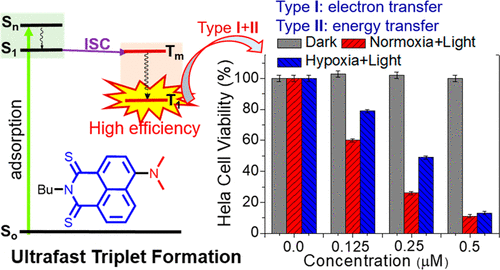
김상인(제1저자, 통합과정생)
A novel strategy for designing highly efficient and activatable photosensitizers that can effectively generate reactive oxygen species (ROS) under both normoxia and hypoxia is proposed. Replacing both oxygen atoms in conventional naphthalimides (RNI-O) with sulfur atoms led to dramatic changes in the photophysical properties. The remarkable fluorescence quenching (ΦPL ≈ 0) of the resulting thionaphthalimides (RNI-S) suggested that the intersystem crossing from the singlet excited state to the reactive triplet state was enhanced by the sulfur substitution. Surprisingly, the singlet oxygen quantum yield of RNI-S gradually increased with increasing electron-donating ability of the 4-R substituents (MANI-S, ΦΔ ≈ 1.00, in air-saturated acetonitrile). Theoretical studies revealed that small singlet–triplet energy gaps and large spin–orbit coupling could be responsible for the efficient population of the triplet state of RNI-S. In particular, the ROS generation ability of MANI-S was suppressed under physiological conditions due to their self-assembly and was significantly recovered in cancer cells. More importantly, cellular experiments showed that MANI-S still produced a considerable amount of ROS even under severely hypoxic conditions (1% O2) through a type-I mechanism.

 Power Factor of One Molecule Thick Films and Length Dependence
Power Factor of One Molecule Thick Films and Length Dependence
 Ga‐Based Liquid Metal Micro/Nanoparticles: Recent Advances an...
Ga‐Based Liquid Metal Micro/Nanoparticles: Recent Advances an...

















